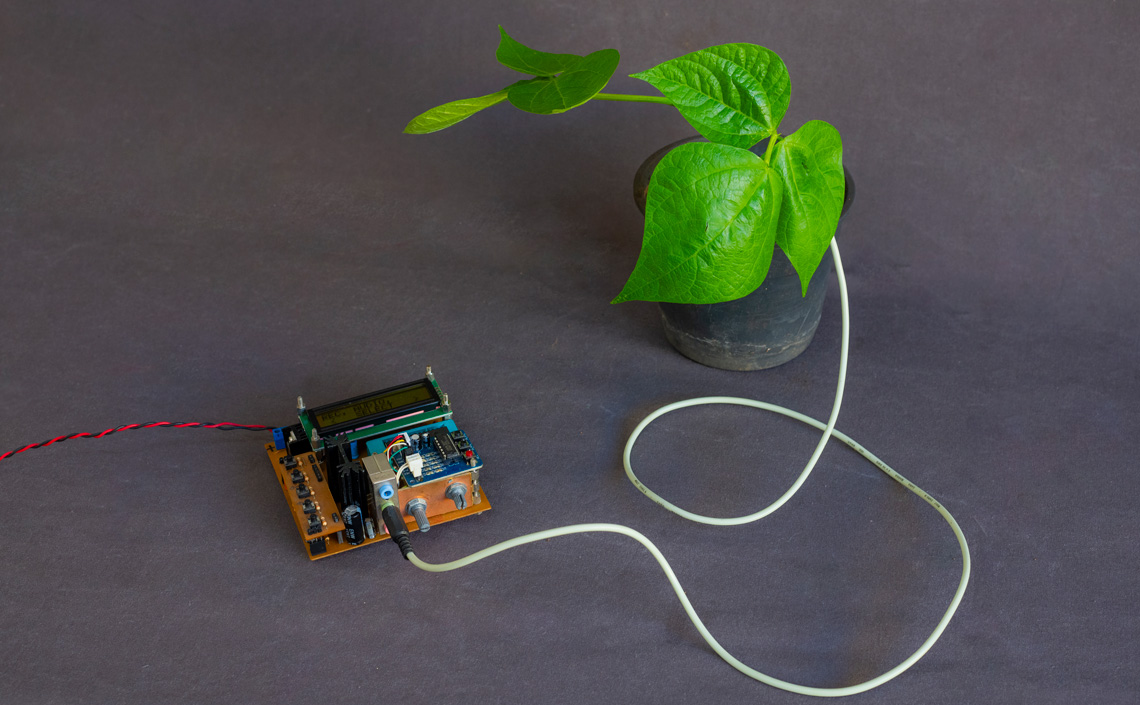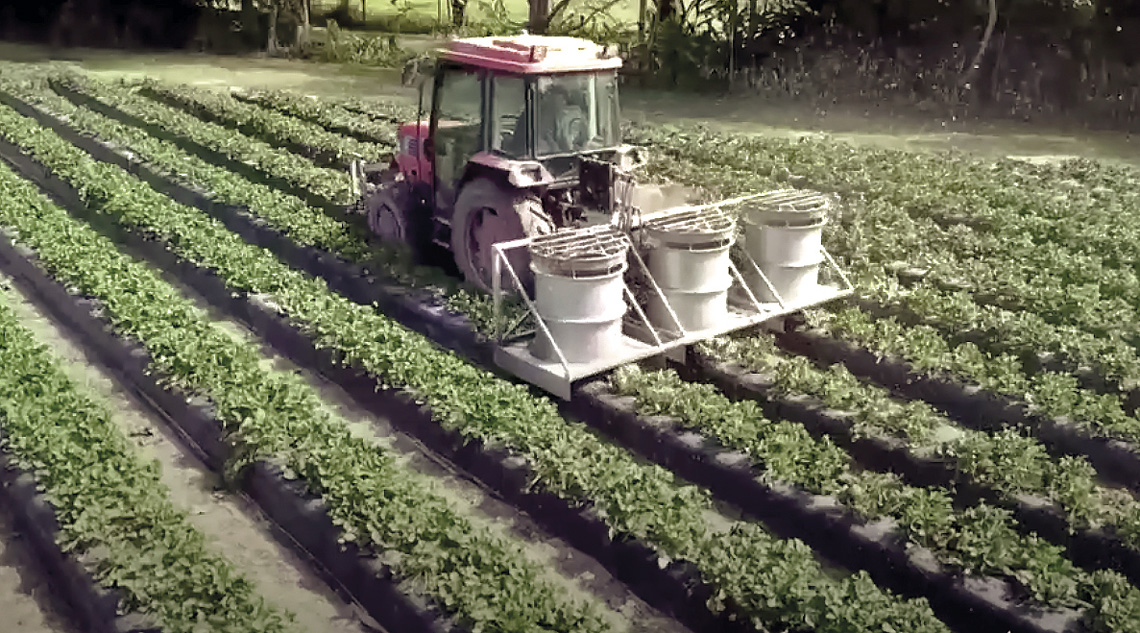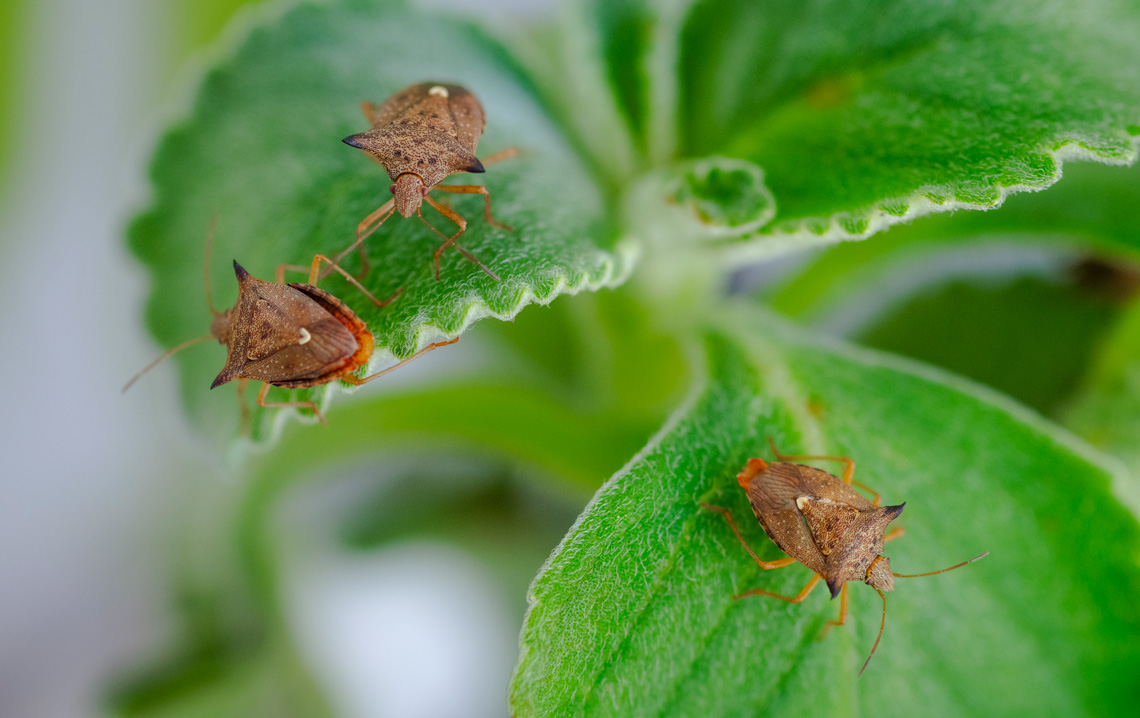One of the latest innovations to fight a major agricultural pest¾the brown stink bug (Euschistus heros)¾resembles a computer circuit board, with rounded and angular chips that only electronics experts can name. The device mimics the vibrations stink bugs use to communicate, transmitting low-frequency vibrations of 60 to 130 hertz (Hz) to solid surfaces such as soybean plants and insect traps. In field tests, the prototype developed at EMBRAPA Genetic Resources and Biotechnology (CENARGEN), in the Federal District, and at Mato Grosso State University (UNEMAT) has shown that it can attract insects.
These insects, which are 12 to 15 millimeters (mm) long, suck on the leaves and seeds of soybeans and corn, causing farmers to lose crops. The first step in reducing damage is to monitor the number of insects in the crop. This is done using the drop-cloth method, which consists of placing a white cloth measuring about 1 square meter (m2) on the ground between two crop rows. The plants in either row are then shaken for a few moments so that the bugs fall onto the cloth.
Farmers can estimate the population size by manually counting the number of insects caught on the cloth. It only takes an average of two bugs to fall onto the cloth to know that it is time to start controlling the pest population, generally with insecticides. One application per crop costs about R$130 per hectare (ha), and sometimes up to three applications are needed. In the 2022/2023 harvest, corn will occupy 21 million ha and soy almost 45 million—1 ha is equivalent to 10,000 m2.
“Our plan is to incorporate this device into a trap that catches the insects and monitors their population. We can also install sensors that identify and count the captured insects,” explains biologist Raúl Laumann, from CENARGEN, who is one of the scientists responsible for the innovation. “With this device, we can automate stink bug detection and send real-time information to the farmer, pinpointing which areas need more attention. This would allow us to make better decisions about which control technique to use and when,” he adds.
According to Laumann, this strategy can be used in tandem with other techniques, such as the use of pheromones, volatile chemical compounds that circulate through the air and facilitate communication between members of the same species. They are used by insects to attract mates, demarcate territories, or warn of danger.
In the early 1990s, biologist Miguel Borges, also of CENARGEN, isolated and synthesized methyl 2,6,10-trimethyltridecanoate, the active ingredient in the E. heros pheromone. These synthetic pheromones can be used to track, identify, monitor, and control insect populations. The substance confuses and deceives them: when they identify the male’s smell, the females are attracted to the trap and fall inside (see Pesquisa FAPESP issue nº 189).
“The pheromone is effective for long distances, within a radius of around 100 meters [m], while vibrations are used for shorter distance communication,” notes Laumann. By moving rigid structures in its abdomen called sclerites, the stink bug uses its legs to transmit the vibrations, which can travel 2 m through crops until they are picked up by the receptors on the legs of other stink bugs.
It has long been known that insects communicate using sound signals. Since the 1980s, scientists from several countries have shown that the use of vibrations transmitted through solid surfaces is also a common form of communication between insects. In the case of stink bugs, vibration signals are involved in short-range attraction.
In addition to the brown stink bug, the CENARGEN team has studied other species, including the red-banded stink bug (Piezodorus guildinii), the neotropical red-shouldered stink bug (Thyanta perditor), and the green stink bug (Chinavia impicticornis). The group found that each species has a repertoire of characteristic signals, as detailed in a 2005 article in Physiological Entomology, written in collaboration with biologist Andrej Čokl, from the National Institute of Biology in Ljubljana, the capital of Slovenia.

Diego BresaniA prototype for the device that transmits stink bug vibrations connected to a bean seedlingDiego Bresani
Other studies were conducted by the Brazilian and Slovenian groups. In one of them, the scientists examined the vibrations produced by E. heros and concluded that they were similar to those of European stink bugs, also considered a threat to crops. They all vibrate at frequencies between 60 and 130 Hz, with an average of 100 Hz, but they differ in the duration and signal repetition patterns.
In another joint study, the results of which were published in 2018 in the Journal of Pest Science, researchers demonstrated how artificial signals could interfere with the reproductive behavior of E. heros. In a long-term experiment, in which the insects were subjected to vibrations in the laboratory for 24 hours, their mating frequency was reduced by 24.7% when compared to the control group. “Females exposed to the background noise have reduced fecundity and fertility,” note the study’s authors.
Insecticide resistance
In 2012, after attending a lecture by the CENARGEN team on this subject, a master’s student at UNEMAT decided to dedicate himself to designing a device that could artificially reproduce the signals emitted by insects. The Mato Grosso State Research Support Foundation (FAPEMAT) approved the proposal, but the student later dropped out of the course.
“I had a project approved in my name, as the researcher in charge, and the mission was to develop an electromechanical device capable of reproducing the stink bug’s vibration signals, so that the insect would believe it to be a natural signal,” says agricultural engineer Tadeu Miranda de Queiroz, from UNEMAT, who volunteered as the advisor for the project he eventually took over.
“It was up to the UNEMAT team to develop software and hardware that would work together to record, store, and reproduce the insects’ vibration signals,” recalls Queiroz, who has a background in developing automated systems for agriculture. “An important part of the challenge was finding a physical [electromechanical] means of generating vibration signals based on the original files compiled by CENARGEN, which feature a collection of the stink bugs’ vibratory songs,” says the UNEMAT researcher. A patent application has been submitted for the software, hardware, and electromechanical device, as a single unit, to the National Institute of Industrial Property (INPI).
The compact, affordable, and portable device reproduces the appropriate frequency, amplitude, and power of the vibrations. It is the first prototype with a wide range of applications in the field, but it still needs further development,” Laumann admits. EMBRAPA is currently looking for a partner to finalize the device and bring it to market.
“This type of technology has the potential to be quite significant in stink bug control and management and is worth the investment,” comments biologist Raul Guedes, from the Federal University of Viçosa (UFV), who was not involved in the study. “Pesticide application on soybeans for stink bug control is substantial, expensive for farmers, and detrimental to the environment and human health. In addition, many species of stink bugs are becoming resistant to insecticides.”
The road from invention to the field, however, can be long. In 2016, the stink bug pheromone was patented and licensed by EMBRAPA to Isca Tecnologias, a bioinsecticide company with its sights set on developing a trap. The CEO of Isca Latam, Leandro Mafra, says that the product has already been developed and they are working on legal, regulatory, industrial, and commercial issues in order to feasibly launch the product. There is no forecast as to when the process will be completed.

Ashbern FarmsInsect aspirator created by Australian farmer Brendon HoyleAshbern Farms
Unconventional solutions can help rid crops of threats
Until pheromone traps and electronic devices become available, farmers seeking to reduce their insecticide use can employ simpler alternatives to monitor and eventually control the presence of stink bugs in their soybean crops. One of these methods, developed by EMBRAPA Soja, consists of using traps that contain plastic bottles filled with a solution of cow urine and table salt (sodium chloride). The recommended proportion is 3 liters (L) of urine and 500 grams of salt dissolved in 7 L of water¾the urine is collected directly from the cows, which are stimulated using perivulvar massage. The traps should be attached to stakes and placed along the border or inside the soybean field every 30 to 50 meters. Attracted by the smell, the insects fall in the liquid and die.
In Australia, farmer Brendon Hoyle used an industrial-sized insect vacuum towed by a tractor, similar to the one he had seen in the United States, to keep his strawberry crop free of insecticides and fruit flies. His version uses three large vacuums, installed inside barrels, which pass over the strawberry beds and suck up the insects attached to the leaves, without damaging the plant (photo above). The vacuumed fruit flies are crushed on a grid that covers the top of each barrel where the vacuums are located. In two years, the number of fruit flies decreased by 75% to 90%. In 2022, Hoyle won the Australian Organic Industry’s Farmer of the Year Award for his invention.
The story above was published with the title “How to trick stink bugs” in issue 342 of august/2024.
Scientific articles
MORAES, M. C. B. et al. Vibratory signals of four neotropical stink bug species. Physiological Entomology. Vol. 30, pp. 175–88. May 2005.
LAUMANN, R. A. et al. Substrate‑borne vibrations disrupt the mating behaviors of the neotropical brown stink bug, Euschistus heros: Implications for pest management. Journal of Pest Science. Vol. 91, pp. 995–1004. Feb. 20, 2018.
